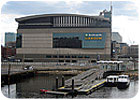
Air curtains were chosen for the TD Banknorth Garden as much as for aesthetics as for performance. Each recessed 3,624-cfm air door distributes a maxi-mum 3,500 fpm stream of air angled directly down toward the floor, thus cold (or hot in the summer) train shed air and fumes are kept outside of the receiv-ing area.
Extending the TD Banknorth Garden’s commuter foot traffic area 100 ft into the adjacent train shed relieved congestion. However, it took innovative HVAC engineering and architecture to make the retrofit an energy-saving and aesthetic solution.
Previously, thousands of mass transit commuters were funneled into the cramped congested lobby/walkway area of the Massachusetts Bay Transit Authority’s (MBTA) renowned North Station terminal inside the TD Banknorth Garden, the home of the Boston Celtics and Boston Bruins. The successful multi-million dollar expansion, developed and funded by Delaware North Companies, Inc. (the owner the TD Banknorth Garden), now greets commuters with a very energy-efficient indoor environment thanks to air curtains, proper building pressurization, and an innovative and aesthetic HVAC, supply soffit system.
Meeting Rush Hour Demand
Previously, the MBTA’s narrow 30-ft-wide lobby/walkway area’s traffic spilled over into the automatic entry door sensor zones, thus exterior sliding double doors remained open continuously during rush hours, resulting in significant energy losses into the open-ended train shed. While the renovation’s main objective was better traffic flow and a roomier waiting area, controlling energy losses through more efficient doorways was also a major concern.“We knew going into this project that one of the greatest challenges was saving energy for the client, because many doors would be constantly open from continuous foot traffic,” said Jeffrey Fleishman, HVAC project engineer, Cosentini Associates.
The design team’s solution to congestion relief was a build-out of the lobby 100 ft into the 200-ft-long by 260-ft-wide train shed. In the redesign, the existing 12 sliding commuter doors were moved out 100 ft and incorporated into a new curtain wall. Designed by architect firm Sasaki Associates Inc., and built by the project’s general contractor, Tishman Construction Corp., the innovative perimeter soffit aesthetically caps the curtain wall and also functions as a concealment for the necessary electric, HVAC piping, ductwork, fire safety, and other utilities.
The soffits also became perfect receptacles for housing 12 high-efficiency In-Ceiling Mount air curtains by Berner International. The 72-in.-wide air curtains complemented Sasaki Associates’ aesthetics for the new entrance area because they’re completely recessed into the bottom of the soffit, appearing only as decorative white aluminum grilles. Each 3,624-cfm air door distributes a maximum 3,500 fpm stream of air angled directly toward the floor, thus cold (or hot in summer) train shed air and fumes can’t infiltrate the receiving area.
Cosentini utilized Berner’s factory-installed coil/filter combination options offered on many of its models, thus the In-Ceiling Mount units all have hot water coils that tap into the soffit’s heating supply loop. The 95,600 Btuh coils supplement the new entrance area’s main HVAC system by providing thermostatically controlled heating near the door areas, when needed. The air curtains also include Berner’s Comfort Plus Control Package, which includes a thermostat, three-speed fan with easy maintenance access from an onboard control panel, a timer delay function, and a low-voltage relay for tapping into any DDC BAS, such as the Garden’s Siemens BAS, if needed. The control package provides two units for the price of one: an air curtain performance/wind stopping unit when the door is open, plus a cabinet heater or low-velocity and low-noise with high heat output when the door is closed.
Turning Losers Into Winners
Summer operation uses the air curtain’s recirculation mode. The In-Ceiling Mount air inlet efficiently draws cooler tempered air from the floor area. The previous doorways were significant energy losers according to Fleishman’s pre-construction energy observations. Conversely, keeping heat in and cold winter weather out with air curtains in the new terminal area is saving the building owner a significant amount of energy. Matt Freitas, sales engineer at manufacturer’s representative, Equipment Direct Sales, provided sizing, energy saving estimations, and design assistance for Cosentini on the air door portion of the project.To heat/cool the entire new space, the Cosentini design team specified a 14,900-cfm McQuay International makeup air AHU that was installed by Walsh Mechanical in the Garden’s mechanical room, which already had an outdoor airshaft for easy access. The HVAC system installation’s most difficult challenge was running the 200-ft long supply duct through a congested mechanical room and down an aisle of ice rink compressors that needed service accessibility clearance.
Exposed metal ductwork with registers distributes heating or cooling down the center of the new waiting area. The AHU is sized and designed to heat/cool the space to a design temperature of 72°F with a 200-person capacity occupancy. The air curtains’ heating function also supplements the indoor air comfort.ES





